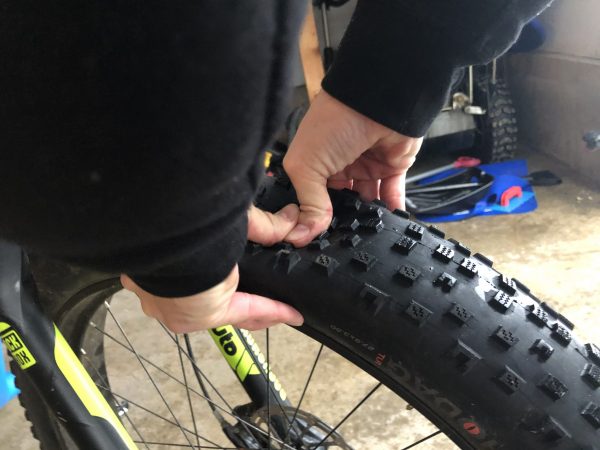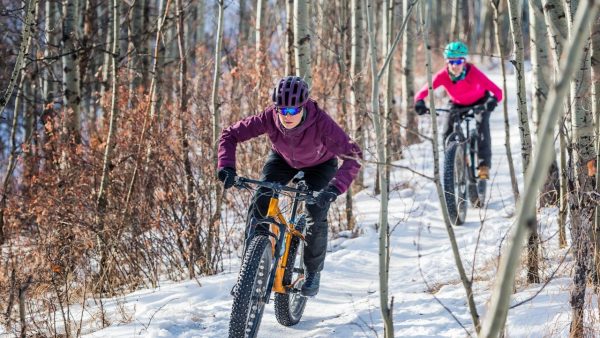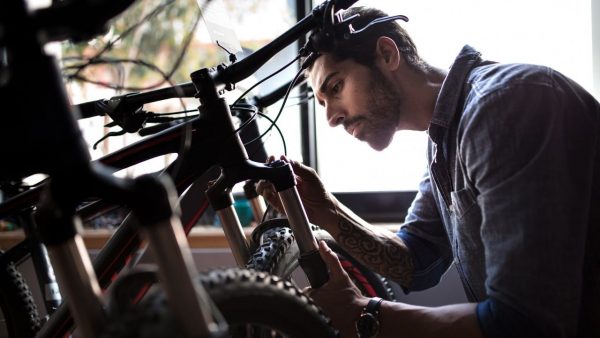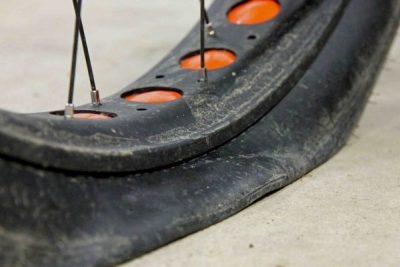There is nothing worse than getting a flat tire when riding a bike, regardless of the type of bike you have. It seems like every fat tire comes out of nowhere, which only makes matters worse.
Fat bike tires are certainly not as vulnerable to flats as others, but when it does happen, it puts a damper on an entire day.
While nothing can completely, 100% prevent a flat tire from happening on the road or trail, there are some steps to lower the chances of something happening.
By following a few of these basic tips, there will be less time looking for some way to fix a troubling issue.
1. Pay Attention To Tire Pressure

Tire pressure is something a lot of people need to adjust to when they first purchase a fat bike. While road bike tires are meant to be inflated at over 100 psi, and mountain bikes can sit in the 20 – 40 psi range (depends if their tubeless), it seems crazy at first to only put less than 10 psi in a fat bike tire.
Many fear that it could cause a pinch flat by going that low, which happens when a person hits a bump and a tire compresses against the rim.
The bigger issue is overinflation with fatbike tires. A tire doesn’t necessarily go flat, but the tube can blow if there is too much air in the tire. This can make a situation very tough to navigate out of.
Always make sure to check tire pressure before going out on a fat bike ride. When in doubt, go with a lower psi, because most people need to train themselves to think that way.
Fat bike tires are much less vulnerable to having a pinch flat compared to road or mountain bikes. It can happen, but it is so rare that no one should be riding worried about the possibility.
2. Ride Fat Bikes In The Right Areas

If a person is anxious about fat bike tire issues, one way to combat them is to always ride in ideal situations. That means picking trails that are well-groomed and made specifically for fat bike riders.
Going off course a lot and riding on a more urban setting is fine, but there is more of a chance of something crazy causing a fat bike tire flat.
A lot of times, riders give this false sense of security when on a fat bike. These tires are indeed virtually indestructible in many cases, but it shouldn’t always be assumed that a person runs no risk whatsoever of having an issue.
Riding in an area that is a bit foreign and not built for fat bikes will always make the chance of a flat tire go up.
3. Basic Inspections

Tires don’t need too much maintenance, but it is worth looking around to see if there is anything possibly causing issues. One way to prevent your fatty from having a flat is to simply keep the tire as clean and free of debris as possible.
Tires can pick up so many different things along the way, and although it might not do damage initially, it could potentially come back and cause issues. Think about things such as glass, shards of rock, thorns, and more.
Fat bikes are more susceptible to getting these types of punctures in the tire during warm weather, as snowy conditions can smooth out surfaces that might otherwise have these issues.
People who treat their tires well will notice they do not start to show wear and tear too quickly. It is tough for people to avoid this if the fat bike is old, but doing things like basic maintenance and not storing the bike outside is a good move to start out with.
Fat bikes start to show some significant wear when they are exposed to the elements all the time.
4. Consider Going Tubeless
A lot of fat bike riders fed up with having flat tires will switch to tubeless tires. It is going to cost a little bit more money at first, but people like the trade-off of not having to stop nearly as frequently.
There is still a chance of something going wrong with the tire, but with no tube, there is no chance of a pinch flat or other issues related specifically to tubes.
Another reason why many fat bike riders love going tubeless in particular is that it helps with shock absorbency when riding over rugged terrain. It can be very difficult for people to learn how to handle all the different bumps along the way at first, so a tubeless tire is actually perfect for first-time riders.
5. Using Tube Sealants

For some added reinforcement, there are some products out there that do an excellent job of helping fat bike tires stay strong. Tube sealant is one of those options, and it helps to fix a flat tire, and avoid future flats.
A sealant works very straightforward, as just a little bit is squeezed to coat the inside of a tire tube. This sealant will fill the leak and makes it just as strong as ever before. The sealant will last as long as the tube will in many cases. That means there are no worries to have to apply the sealant again later on.
6. Tire Liners (Tuffy Fat Bike Liner)
A tire liner is another option for people who are looking for ways to make their fat bike virtually flat tire proof. This liner helps fight against any of those small, sharp objects that become a big issue.
Think about road debris, broken glass, thorns and other objects that might not even be seen on the ground initially.
One of the best liners out there right now for any type of bike is the Mr. Tuffy fat bike tire liner. It is a relatively inexpensive product that is easy to apply at home without any professional assistance.
Once the liner is put on, a person never has to do any additional maintenance whatsoever. It becomes part of the bike and an extra layer of protection that so many people can benefit from.
Since Mr. Tuffy fat bike tire liner works so well, many people don’t need to have a sealant as well. This is another reason why it is effortless to cut down on costs and not worry about too much when riding around.
Having one less thing to worry about is undoubtedly beneficial for any type a person out there who wants to have a carefree experience when fat bike riding.
A tire liner makes a lot of sense for any type of bike, but fat bike tires in particular benefit greatly from them. It makes a very tough and durable tire that much stronger in general.
People don’t have to worry nearly as much about something going wrong, and that allows for more exploration on a fat bike. Instead of always trying to stay too close by, a person can explore a little more and see what happens.


To get tires 100pis